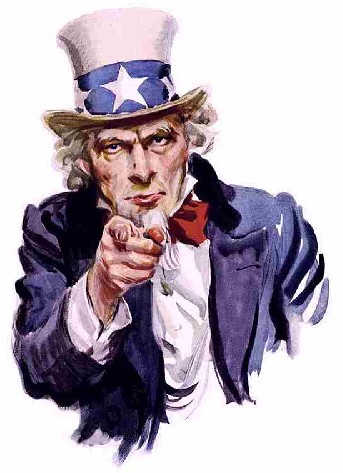
Uncle Sam is the nickname of the superpower United States, is also a symbol of the country. Who's behind the name is still a question mark.
Many people believe Uncle Sam really existed. He was a real character who lived early 19th century.
"Uncle Sam ever really existed. His name was Samuel Wilson and he was a supervisor at a meat company that supplied the meat rations for soldiers during the War of 1812, "wrote Bill Lawrence in the Fascinating Facts From American History.
Samuel Wilson is believed to be born in Menotomy (now Arlington), Mass., on September 13, 1766. He was a bricklayer before finally working as a supervisor at a company owned by his uncle, Elbert Anderson, businesses that supply meat ration the U.S. military in the War of 1812. At that time the United States, which declared war on June 18, 1812, tried to seize Canada from Britain's hand.
Uncle Sam's story begins with logo branding on the drums of the army rations containing meat. Logo on display is the U.S.-some call "EA-US", referring to the name of Elbert Anderson EA while the U.S. stands for United State. One day, one soldier in a tone of banter ask their friends about the U.S. stands for. His friend replied: maybe Uncle Sam (Uncle Sam). Local newspaper and then picked up the story. Troy Post was mentioned first on it, on 7 September 1813. Uncle Sam's name was spreading.
"In this way, stands for the U.S. to give way for Uncle Sam as the personification of the U.S. government," writes Sondra Abel Y Reading in Preparation for State Assessments.
Previously, the figure of the famous cartoon is the Brother Jonathan, a fictional character who personifies the American people when the country was not long stand, regardless of origin state. He was described as a typical American revolutionary. Egalitarian character of the new republic continued until the mid-19th century and began to fade as the Civil War broke out between 1861 and 1865. America needs a unifying symbol, especially after the Civil War and the conflict with Britain.
At that time England still compete with the French at the stage of global politics. The U.S. allied with France, which aggravate relations with Britain. Characteristics Brother Jonanthan thin and short is considered not appropriate and not compete with the character of John Bull of England a fat and rich. This is where Uncle Sam showed up, which is shown face to face with John Bull of England.
Initial character John Bull comes from a character in the book The History of John Bull by John Arbuthnot in 1712. A number of caricaturists and create a caricature, but he became famous in the hands of Sir John Tenniel who publish in the British humor magazine, Punch. John Bull and so the propaganda media empire. Uncle Sam and John Bull finally be on a more equal and mutual respect. One look at the picture cover song called "John Bull and Uncle Sam" output in 1898 to celebrate the peaceful resolution of US-UK on the Venezuelan border dispute.

In the late 1860s and 1870s political cartoonist Thomas Nast began to popularize the image of Uncle Sam. Nast continue to develop and be the basis of the character of Uncle Sam is now known. But Uncle Sam's famous images created an American illustrator and poster designer, James Montgomery Flagg. His figure is described as having short jengggot, magician-style hat and coat, and hands pointing, with the words: "I Want You for U.S. Army" for recruitment posters during World War I. Figure Flagg became popular, first used the cover of Leslie's Weekly in July 1916. The poster was also used to spread and several times with different information.
"Uncle Sam poster inspired by an advertisement from the UK who describe Lord Kitchener (who was appointed commander of the British war hero because of his victory in the fighting in Sudan)," wrote Jonathan Gabay of Soul Traders. In the poster of Lord Kitchener's pointing finger, and below are listed the words: "Your Country Needs You".
And the story of Uncle Sam survives until today. Samuel Wilson himself died at the age of 88 years. He was buried in Oakwood cemetery in Troy, New York, a city which mentions himself as "Home of Uncle Sam."
Not a few who doubt the story behind Uncle Sam because there is no printed matter in a long time which tells Uncle Sam. Cecil Adams of The Straight Dope, for example, wrote that the story never appeared in print up to 30 years after the event. Troy Post in 1813 nor had he ever preach about Wilson. The distance between the events and the news led to misinterpretation and memory defects.
According to its website etimolog barrypopik.com Barry Popik, a detailed explanation of the origin of Uncle Sam comes from the New York edition of the Gazette May 12, 1830. But he concludes the story of Samuel Wilson was a myth, not the origin of Uncle Sam's official symbol. Popik has several reasons. Among others, the writer at the Gazette New York is anonymous. And no one in Troy and Albany newspapers that mention Samuel Wilson.
The U.S. government did not want to bother about the origins of Uncle Sam. Congress set a resolution on 15 September 1961 which states Uncle Sam as a symbol of the state and Samuel Wilson is the name behind Uncle Sam.
"By honestly, it seems no one really knows for sure Uncle Sam. People of the United States was forced to go through life without knowing where the image of their country's most famous, "wrote Isaac M. McPhee, a graduate of English Literature at Western Washington University, in "Uncle Sam: A Brief History of America's Greatest Symbol" published americanhistory.suite101.com.
Source
